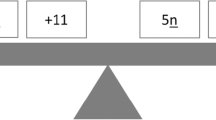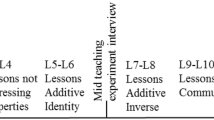Abstract
This study examines Australian students’ conceptions about ordering decimals. It builds upon previous work which established three common misconceptions. A longitudinal study of 50 secondary students over twelve months showed little change in their misconceptions. A second study traced the incidence of each misconception from Years 4 to 10 in a sample of 379 students. It was found that the whole number misconception was important in earlier years but disappeared with time. The fraction misconception persisted, being displayed by approximately twenty per cent of Year 10 students. The zero-rule misconception was uncommon. The diagnostic test, which substantially improved on one used in previous research, may be very useful for teachers.
Similar content being viewed by others
References
Board of Studies (1995).Curriculum and standards framework (mathematics). Melbourne: Board of Studies (Victoria).
Brown, M. (1981). Place value and decimals. In K. Hart (Ed.),Children’s understanding of mathematics, 11–16 (pp. 48–65). London: John Murray.
Carpenter, T., Corbitt, M., Kepner, H., Lindquist, M., & Reys, R. (1981). Decimals: Results and implications from national assessment.Arithmetic Teacher, April, 34–37.
Grossman, A. (1983). Decimal notation: An important research finding.Arithmetic Teacher,May, 32–33.
Moloney, K. (1994).The evolution of concepts of decimals in primary and secondary students. Unpublished Master of Education Thesis, University of Melbourne.
Moloney, K., & Stacey, K. (1996). Understanding decimals.Australian Mathematics Teacher 52(1), 4–8.
Nesher, P., & Peled, I. (1986). Shifts in reasoning.Educational Studies in Mathematics, 17, 67–79.
Resnick, L., Nesher, P., Leonard, F., Magone, M., Omanson, S., & Peled, I. (1989). Conceptual bases of arithmetic errors: The case of decimal fractions.Journal for Research in Mathematics Education, 20(1), 8–27.
Sackur-Grisvard, C., & Leonard, F. (1985). Intermediate cognitive organizations in the process of learning a mathematical concept: The order of positive decimal numbers,Cognition and Instruction, 2(2), 157–174.
Author information
Authors and Affiliations
Rights and permissions
About this article
Cite this article
Moloney, K., Stacey, K. Changes with age in students’ conceptions of decimal notation. Math Ed Res J 9, 25–38 (1997). https://doi.org/10.1007/BF03217300
Issue Date:
DOI: https://doi.org/10.1007/BF03217300




